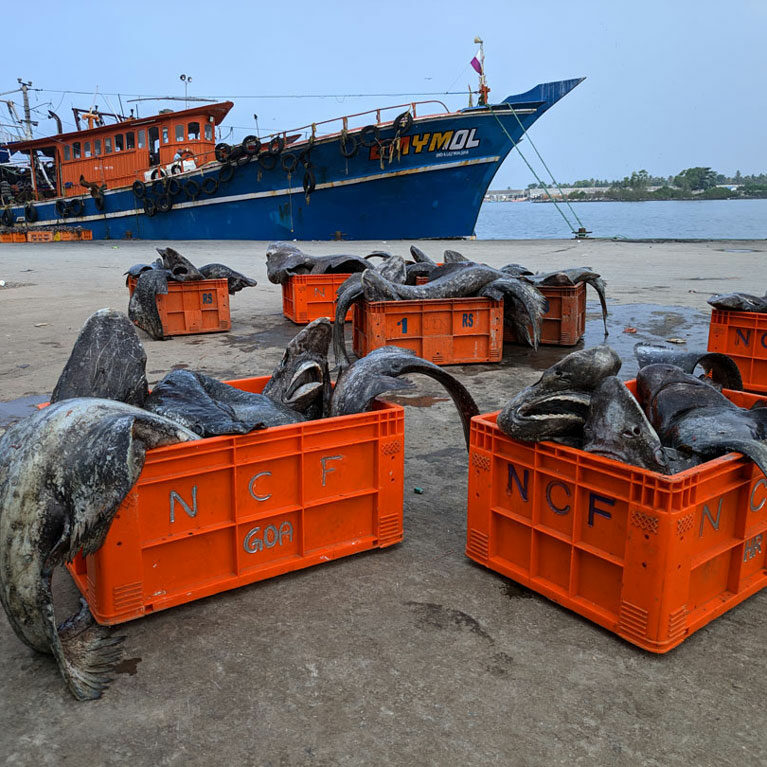Amending the understanding of deep-sea Gulper sharks of India
Ebeena is uncovering new information about the abundance and diversity of gulper sharks. Her focus is on three landing sites where deep-sea fish are brought ashore, and where she collects tissue samples and documents bycatch from these fisheries. The project aims to clarify taxonomic confusion about gulper sharks, and will centre on Cochin in Kerala on India’s south-west coast, Thothoor in Tamil Nadu on India’s south-east coast and the Andaman and Nicobar Islands.
Ever since I can remember, I have been fascinated by the ocean and the life under it. I was born and raised in the town of Kochi – popularly known as the Queen of the Arabian Sea – on India’s south-western coast in the state of Kerala. Growing up in a seaside town, I spent most of my childhood exploring the coastline. Crabs were my best friends and playing around them was my ultimate happiness. In those young days, I was very frightened of sharks and scary movies and stories about them were the stuff of nightmares for me. That...


Amending the understanding of deep-sea Gulper sharks of India
To understand the diversity, abundance and distribution of gulper sharks in India and to formulate suitable conservation strategies.
India’s gulper shark population is declining drastically as a result of high fishing pressure driven by the demand for squalene from the sharks’ livers, which is used in the manufacture of pharmaceutical products. So great is the decline that it may lead to the local extinction of these species. This project aims to provide information about the diversity, abundance and distribution of gulper sharks in India, which can be used to formulate conservation strategies.
A number of deep-sea shark species, such as Ehinorhinus brucus, Centrophorus squamosus, C. atromarginatus, C. granulosus, C. moluccensis, Squalus mitsukurii, S. hemipinnis, Etmopterus pusillus and Zameus squamulosus, are targeted by fisheries in India. Centrophorus spp. (gulper sharks) are the main target and are commercially exploited for the high squalene content of their livers. The demand for squalene on the international market is reflected in the shift of the elasmobranch fishery in India from coastal sharks and rays in the 1980s to deep-sea sharks like Centrophorus spp., Echinorhinus brucus and Squalus spp. in more recent times. In addition, large numbers of juveniles are taken as by-catch in deep-sea shrimp trawl nets. The high fishing pressure on these species over the past few years has led to a decline in the catch rate of gulper sharks in Indian waters. Moreover, low fecundity, late maturing and a long lifespan compound the population decline, preventing a quick recovery. All these factors raise the alarm for gulper sharks in India and demand that immediate attention be given to their predicament. My work focuses primarily on systematically collecting information about the data-deficient gulper sharks that can be used to formulate conservation policies and mitigation measures.
The objectives of this project are
- To determine the catch composition, abundance, distribution and population characteristics of gulper sharks along the Indian coast;
- To resolve taxonomic issues in India’s gulper sharks by means of DNA;
- To determine which species are taken as by-catch in the targeted fishery for squalene and to quantify those discarded.
Summary of main research results/outcomes
During the study period, 419 specimens of sharks belonging to the family Centrophoridae were collected and identified as Blackfin gulper shark Centrophorus atromarginatus Garman, 1913, Gulper shark Centrophorus granulosus (Bloch & Schneider, 1801), Leafscale gulper shark Centrophorus squamosus (Bonnaterre, 1788) and Smallfin gulper shark Centrophorus moluccensis Bleeker, 1860.
Gulper shark fishery in Kollam, Kerala was dominated by C. atromarginatus (38.6%) followed by C. granulosus (34%) and C. squamosus (27%) and were caught as incidental catches in deep-sea shrimp trawlers. The length-weight relationship analysis of gulper sharks in India shows a positive allometric growth pattern for all the species and their gut content analysis revealed a high preference for crustaceans in their diet. The study highlighted the decline in catch rates of Gulper sharks in Indian waters and the corresponding shift of the shark liver oil industry to domestic consumption.
The phylogenetic tree of gulper sharks of India was created to confirm the identity and to resolve the taxonomic confusion.

